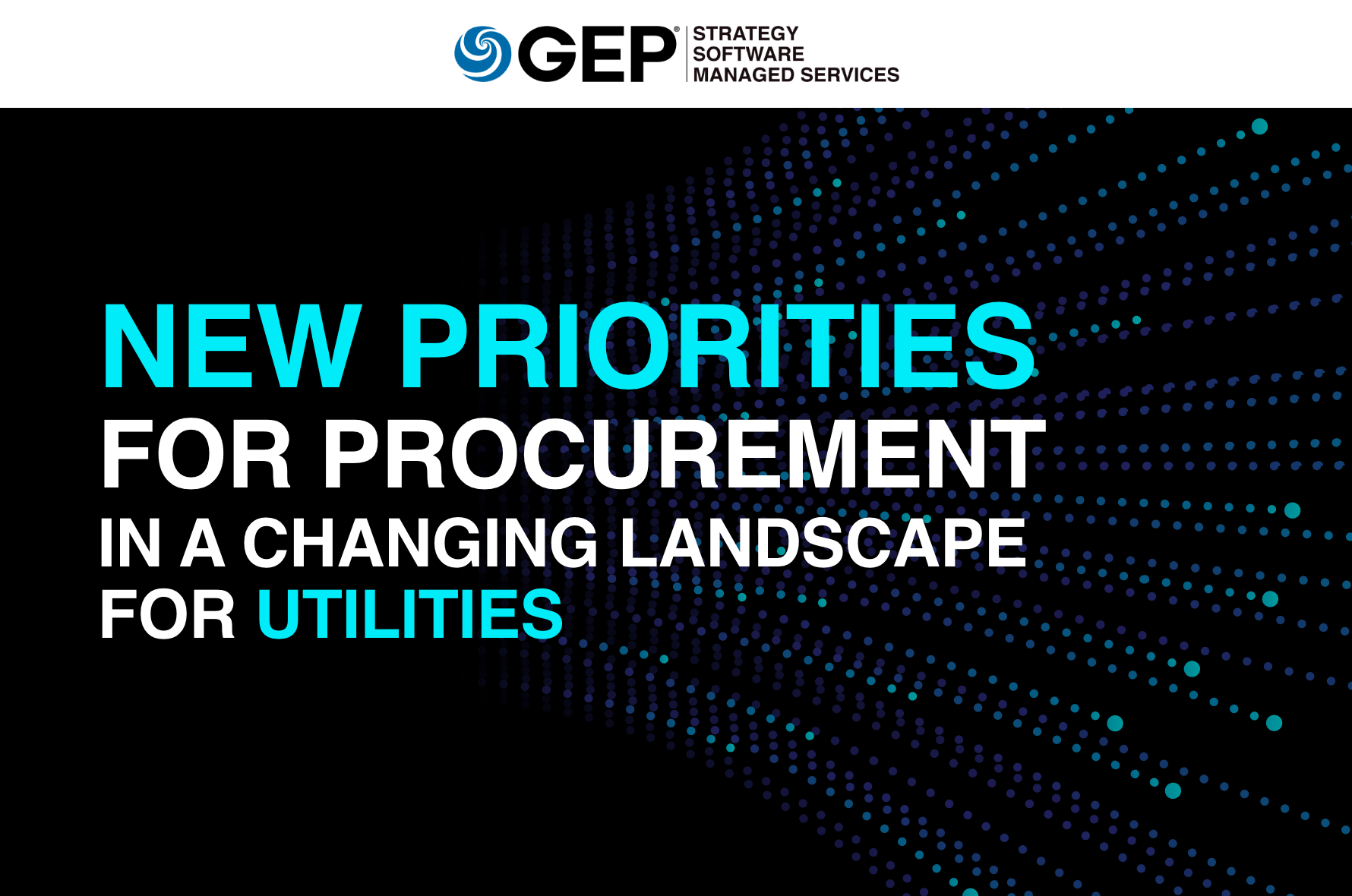In an environment of extreme weather, changing regulations and shifting consumer demand, procurement organizations have the chance to lead utility companies to greater agility, resilience and competitiveness. How should they get started?
New Priorities for Procurement in a Changing Landscape for Utilities lays out the key trends impacting the utilities industry and gives practical insights on how procurement should respond to prepare utilities for disruptions and change.
This bulletin is invaluable reading for procurement professionals in the utilities industry seeking a road map to a rapidly changing sector.
What’s Inside:
- The impacts of extreme weather on infrastructure and regulatory policy
- How to adapt to demand shifts for renewable and traditional energy
- What to watch for as advancements in technology come to market
Download this exclusive report now to help you prepare for the challenges ahead.
In 2022 and beyond, the utilities industry will face rapid change on several fronts due to extreme environmental conditions, shifting consumer demand and innovations in technology and energy efficiency. Procurement and finance leaders have an opportunity to make a meaningful, long-lasting impact by paying attention to these trends and advocating for the strategic change that is needed to adapt.
Weather events are ramping up regulatory pressure
Severe and destructive weather events1 have necessitated more sophisticated policies and regulations, thereby increasing political pressure on utilities. Electric system failures and pipeline explosions due to floods and wildfires are driving regulators to expand their role with increased scrutiny and greater accountability. Lawmakers and politicians are increasing the pressure to break up and restructure utilities. Many are advocating for policy changes to force utilities to become more cost-competitive by considering state- or federally run programs.
Procurement should: Revamp emergency response plans to prepare for major disruptions, including those caused by severe weather conditions, pandemics and other force majeure events that have historically been overlooked. In addition, utilities should invest in advanced technology and weather monitoring systems to track real-time climate changes. Utilities could use advanced modeling of climate and storm data to proactively predict major disruptions.
Demand for renewables is increasing
The world relies on multiple resources to generate electricity and is currently undergoing a rapid change in what sources are providing that power. Renewables are the fastest-growing segment, and are expected to continue to grow steadily through 2050 because of declining capital costs, state and federal tax credits, Renewable Portfolio Standards (RPS) and other regulations and policies.2
Procurement should: Update its strategic plan to account for changing legislation and macroeconomic changes. While most utilities have to comply with RPS, those leading the way are trying to exceed their goals by developing a holistic strategy and, at the same time, take advantage of decreasing costs of wind and solar. Many utilities are leveraging both utility-owned generation as well as long-term Power Purchase Agreements (PPAs). In doing so, supply chain needs to balance the benefits and risks associated with large capital investments and/or long-term contracts. Sourcing should take advantage of a competitive bid to achieve best-in-class pricing for renewables, which will reduce energy costs for its end consumers.
Demand is declining for traditional power sources
Coal-fired generation is declining due to climate change. In addition, nuclear facilities are being forced into retirement in the wake of the Fukushima Daiichi disaster and falling costs of natural gas.3
Procurement should: Expect the retirement of aging assets and consider implications for inventories and other stranded assets. Procurement should work closely with its business partners to understand the remaining operating life of key assets; in many cases, procurement may need to engage engineering and technical experts to help develop a decommissioning plan and/or economic study. As these assets are sold or retired, utility leaders will need a comprehensive plan to transition the workload of those aging assets to renewables, PPAs or other infrastructure.
Technology and energy efficiency are evolving
Advancements in technology are substantially changing the utility ecosystem. Sophisticated control systems are improving safety and reliability. Advanced surveying and mapping technology are enabling more informed decisions. The digital workforce, predictive maintenance, battery storage, automated operations and processes, distributed generation and many other innovations are taking root. Utilities are building less transmission infrastructure due to the increase is energy-efficiency programs, but the demand for electric vehicle charging stations is surging.4
Procurement should: Be prepared for a changing technology ecosystem by studying the market and understanding how technological innovations are changing behavior. For example, as the demand for electric vehicles increases, additional infrastructure will need to be built to accommodate new charging stations. The location of these charging stations will change the demand on the grid, particularly around shopping malls and populated areas. In addition, the Internet of Things (IoT) will vastly change how a utility operates. Advanced smart meters and wireless devices will move beyond the meter, into people’s homes. IoT will enable energy to be optimized within a house or apartment, not just at the neighborhood level. With these advances in technology, supply chain professionals need to be prepared for changing contract requirements, such as additional cybersecurity requirements and changing consumer privacy laws.
Procurement has an opportunity to lead as utilities evolve
The utilities market is experiencing rapid and continuous change brought on by weather events and climate change, shifting consumer moods and demand, and innovations in technology and efficiency. To face these challenges, procurement professionals must adapt in ways that more closely reflect what is going on in the broader business environment and future-proof their operations.
- A. T. D. Perera, Vahid M. Nik, Deliang Chen, Jean-Louis Scartezzini & Tianzhen Hong, “Quantifying the Impacts of Climate Change and Extreme Climate Events on Energy Systems,” Nature Research, 17 February 2020 │ https://www.nature.com/articles/s41560-020-0558-0
- “Annual Energy Outlook 2020 With Projections to 2050,” The U.S. Energy Information Administration (EIA), 29 January 2020 │ https://www.eia.gov/outlooks/aeo/
- Kelly Andrejasich and Anna Duquiatan, “7 GW of US Nuclear Capacity Could Close in Next 5 Years,” S&P Global Market Intelligence, 26 May 2020 │ https://www.spglobal.com/marketintelligence/en/news-insights/latest-news-headlines/7-gw-of-us-nuclear-capacity-could-close-in-next-5-years-58501877#:~:text=The%20 first%20of%20two%20remaining,before%20their%20licenses%20run%20out.
- “The Future of Electricity: New Technologies Transforming the Grid Edge,” World Economic Forum, 10 March 2017 │ https://www.weforum.org/reports/the-future-of-electricity-new-technologies-transforming-the-grid-edge

